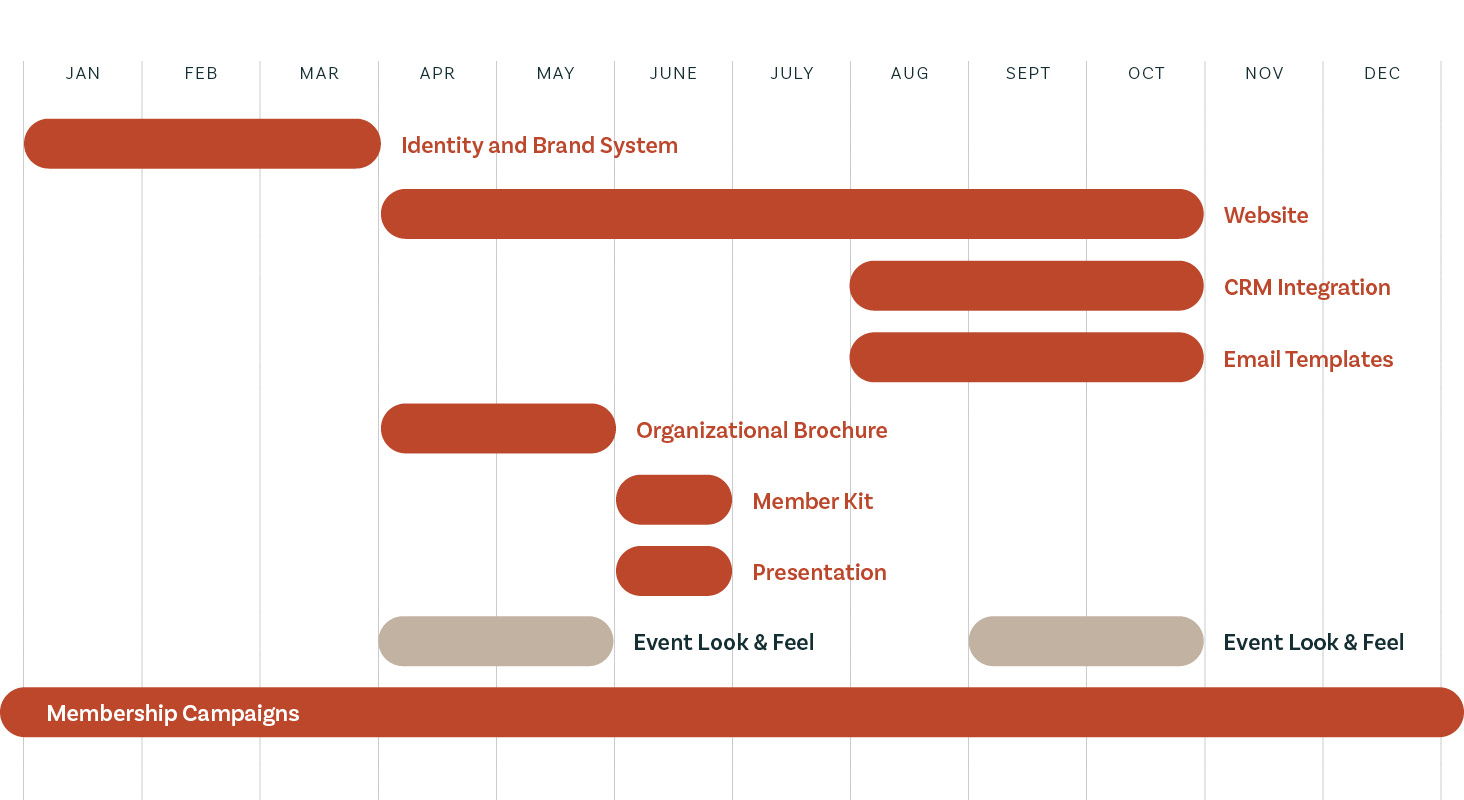Prospective members can meet your organization in several ways: at a mixer, on your Facebook page, through an article on your website, or through an email a friend forwarded them. The combination of those experiences adds up to something critical: their perception of your brand.
If your design is outdated or inconsistent across touchpoints, you’re giving prospects reason to doubt you. And frankly, they’re already skeptical. There’s no question about it: you need to tell one story of who you are in a cohesive brand experience to win new members.
Fonts, colors, textures, and images are not trivial details. All brand elements should reiterate your organization’s mission and messaging. A consistent brand experience builds trust and resonance with each interaction. Isn’t that what you want to offer prospective members?
It might be time for your organization to update your materials, so you’re telling your one story masterfully. However, deciding what to prioritize and how to sketch out a reasonable timeline is challenging. Whether you need to start from scratch or attend to just a few elements, you need a solid plan. Here’s how to get started.
Prepare By Auditing Your Current Brand Materials
Perhaps you know exactly what needs updating. But before making decisions, you’ll need to systematically take stock of and prioritize each asset.
Take Inventory
Account for your website, emails, social media, event materials and displays, webinars, membership collateral, sponsorship materials, and all other assets. Assign each asset a rating from 1-5 based on the level of potential impact it can have on your organization and members.
In addition, document:
- Any asset that isn’t “on brand.” Does any touchpoint conflict with your brand identity? Even small conflicts can have real consequences. For example, prospects can fail to recognize you if your marketing collateral uses a different color palette.
- Any deficiencies. Are you missing any key assets?
- Each asset’s dollar impact. How much value or impact can it generate directly (like additional sponsorship dollars) or lose you in opportunity cost (like lackluster attendance to an event or someone not signing up as a member)
Set a Budget
Avoid determining your materials update budget purely on cost. Instead, consider what investment is reasonable based on the value to be generated. If a positive outcome was likely, what would you invest to achieve that outcome?
For example, if you were told that you’re likely to generate $500k in sponsorship dollars for your event if you invest 10% of that goal on branding the event, would you? This exercise gives you a ceiling for what’s reasonable to invest if there was a high degree of certainty in the results. From there, you can reduce the investment based on your ambitions, available resources, and level of certainty in generating that value.
Allocate Resources
Ensure you have set up adequate internal and external resources to tackle each project. Even if you have the most capable external vendor to help you through this journey, you still need timely information, decisions, and approvals by your internal team.
Create a Brand Asset Update Timeline
The following timeline represents an example of a complete brand update. As you approach this process, be patient and realistic. And bear in mind each part of the update affects the following, so the sequencing is important.

Every organization is different, so you can customize this suggested timeline to one that fits your needs.
Identity and Brand System: Months 1-3
The story you tell, how you talk about yourself, and the value you bring to members should be consistent and complementary. Your logo, colors, fonts, and visual elements bring your story to life in a unique, authoritative way.
Make sure you work diligently — and with an external partner if needed — to build a robust brand system that equips your team and vendors for success.
Website: Months 4-10
Once you’ve solidified your brand identity, you can begin designing and building a website that supports it. The website is your primary communication tool, and it will require the longest time commitment.
Organizational Primary Brochure: Months 4-6
Your brochure is a foundational product that will establish messaging, tone, and visuals. It’s a vital asset that serves as another face of your business and a detailed reference of your services. Subsequent materials (like presentation decks and sales folders) can follow and complement this primary piece.
Membership Management Platform: Months 8-10
As you wrap up work on your website, you’ll integrate your Customer Relationship Management (CRM) software. Your CRM allows members to connect with resources like webinars and registration for organizational events and cannot be an afterthought and disjointed from the rest of their experience on the website.
Email Templates: Months 9-10
Since email drives traffic to the website, design and deploy your email templates post-website launch. Remember: a good email depends on crisp, clear, concise content.
Membership/Sponsorship Sales Folder and One-Sheets: Months 6-7
When you sell a membership, you’ll want to leave a sales folder in that new member’s hands. And one-pagers can be just the right thing when you need a brief, easy-to-read marketing piece. Both of these assets play an important supporting role and build from what you’ve established in your organizational brochure.
Presentation Decks: Months 6-7
Decks can be built alongside sales folders and one-sheets and are also inspired by the established organization brochure, website, and brand guidelines. You’ll use it to present information to potential sponsors, members, or partners. A customized PowerPoint template, another must-have asset, will help you create presentations quickly and professionally.
Event Design: Variable/Ad hoc
Event design has a unique place in your brand update timeline. Membership organizations typically start marketing events a minimum of 2 months in advance. The development of an event look and feel should start 6-8 weeks before you want those materials to go live, depending on the complexity of the event.
A well designed event not only drives attendance, but also helps to communicate the caliber of an event to potential sponsors. Reimagined events have the opportunity to tremendously increase sponsorship revenue.
Membership Campaigns: 24/7/365
Membership organizations like yours need to actively communicate your value with year-round efforts. As soon as the core corporate communications materials (identity system, brochure, and sales kits) are complete, you’re ready for your membership campaign.
Robust, Lively Brands Are More Compelling to Prospective Members
Today’s digital natives have high expectations and low tolerance for counterintuitive, disjointed design. So use all of your brand elements to create and maintain your story and your vision. That’s the way to earn trust and make your organization memorable, impactful, and sustainable to future members.





